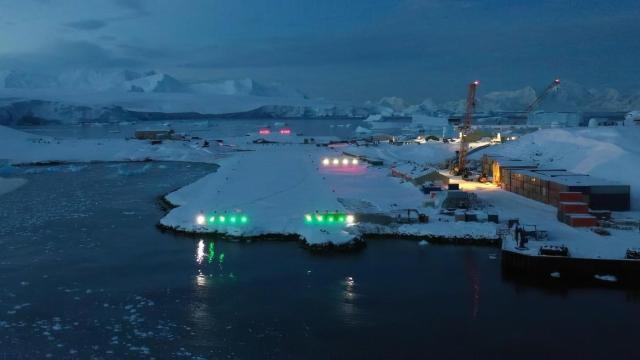It’s a massive undertaking to keep Antarctica, arguably the most inhospitable place on the planet, connected to the rest of the world. There is no indigenous population on the southern-most continent, and anyone or anything needed to sustain the scientific community living there must be brought in by sea or air. The BBC checked in on an ongoing effort to upgrade a British research station’s airstrip, and it sounds like a real pain.
The British Antarctic Survey is modernizing the 32-year-old airstrip at its largest facility, the Rothera Research Station. The biological research centre is located on Adelaide Island, just off the west coast of the Antarctic Peninsula. The station’s population sits at 22 people during the winter when the temperature can drop to -128.6 degrees. The total swells to 100 people when the unrelenting cold eases in the summer months. The relatively warmer period was also the best time to complete the airstrip upgrade, but the weather was still an issue:
One particularly windy day, Maria Gonzalez Rico, associate at engineering firm Ramboll and lead designer on the Rothera Runway project, walked along the runway to inspect some of the upgrade work. The runway is just 900m (3000ft) long and the stroll, which would normally take just 10 minutes, took more than half an hour due to the force of the wind blasting her backwards.
“I was thinking ‘what am I doing here?’,” Gonzalez Rico remembers. “Anything above 20 knots (37km/h or 23 mph) – and we knew it was going to be a hard working day.” The following day, though, the sun shone in a clear blue sky and glittered on the pristine snow. “You get out and see the surroundings, and it reminds you – that’s why. It was an incredible experience, absolutely.”
Crushed rock is used to surface Rothera’s runway, locally sourced in Antarctica to make construction logistics easier. The aggregate is layered by size and bound with seawater. The water evaporates over time leaving salt to hold the surface together. But the project isn’t entirely straightforward, as the crew dealt with snowstorms and the local wildlife:
“You see penguins and seals all the time,” says Gonzalez Rico, “but there are very clear instructions what to do and what not to do if you encounter wildlife.” If seals or penguins need to be moved out of the way, trained personnel are on hand to do it – but no more than five times a day per species. “The main thing to understand,” Gonzalez Rico adds, “is this is their home, not ours. They take priority over anything else.”
It’s incredible how humanity’s southernmost outposts stay operational and consistently supplied. Be sure to read the BBC’s entire feature that delves into the research done at Rothera and the recreational activities during off-hours, including snowboarding.
